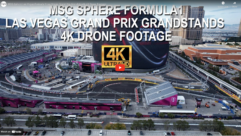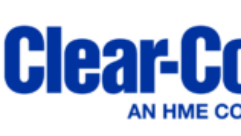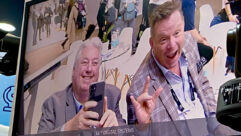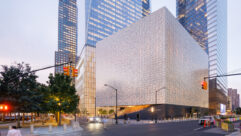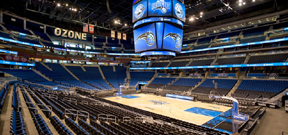
SVC Podcast – Show Notes – Show 144-1:
In this edition of the SVC Podcast, SVC Contributing Editor Bennett Liles talks with John Curtis of CTG in Atlanta about the complete renovation and upgrade of the Orlando Magic’s digital signage system in Amway Center. The project involved the addition of a new Vitec IPTV system designed to dramatically enhance the fans experience by providing them with control over video playback and source switching in the premium seating areas.
Links of interest:
- CTG – Comprehensive Technical Group – in Atlanta
- Vitec, the manufacturer of the IPTV system installed by CTG
- NBA site for the Orlando Magic
Download Podcast Here:
https://s3.amazonaws.com/nb-svc/public/public/144-1_Vitec_Orlando_Magic_…
From Sound & Video Contractor Magazine, this is the SVC Podcast with John Curtis of CTG. Show notes for the podcast are available on the web site of Sound & Video Contractor Magazine at svconline.com.
The Orlando Magic had big plans for a complete upgrade of their digital signage in Amway Center with the addition of an IPTV solution from Vitec. They called CTG in Atlanta to install and test the massive new system. The results are absolutely stunning both to the team and to the fans. John Curtis from CTG is going to take us through the planning and installation, coming right up on the SVC Podcast.
John, thanks for joining us on the SVC Podcast from CTG, the Comprehensive Technical Group, headquartered in Atlanta and offices in Louisiana, Birmingham and Florida, too I think.
That is correct. We’re all across the southeast and doing work nationally these days.
And the project we’re talking about here is not your average low-profile, changing-speakers-in-a-church sort of thing. This was rolled out in front of thousands of Orlando Magic fans. Let’s be honest. Sports fans are not the most patient crowd in the world, especially after they’ve imbibed a little for the game and if something isn’t working right, they’re going to let you know pretty fast.
This is certainly not a low-profile gig for us. Sports fans – most fans – in general these days are looking for their content and they’re looking for it now, so this particular project was pretty monumental from the outset. The folks down at the Amway Center in Orlando had an existing Harris Infocaster system that was doing various feeds. They had a couple of different Harris players that were going out. I believe the total count was right around 900 monitors total, so there was a lot of desire from the Magic to streamline content delivery. And when I say content delivery, it wasn’t just internal content that was going out from in-house video replay systems or anything like that. This was branding across the board from their in-house cable TV system, their in-house feeds, their external feeds, and rolling this all into one system with their digital signage systems including retail point-of-sale, concession stands and really any monitor in the building. They wanted to roll it into one system, so we worked very closely with Vitec and with the nice folks at Four Winds Interactive to put out a system that allowed them to really have that control and to brand the facility not just for Orlando Magic games, but increase revenue with them when they had external events coming in; we were there at the tail end of a very, very large technology conference as we were finishing our project. But giving them the capabilities to really brand the facility and convey their image to their fans, whether it’s Orlando Magic fans or whether it’s other folks that are renting the facility. [Timestamp: 2:59]
Right. And as you said, they had an existing system but it wasn’t just new software on the old system. Your guys had a lot of grunt work to do running cable and mounting displays and everything.
Absolutely. So, you know, on these types of projects we always look to what can we reuse and what needs to come out and be put in new? The nice thing about the Amway Center is using the infrastructure from a cabling perspective was fairly reusable. We ended up not having to really pull cable back. They had the foresight on the original system build to get network drops to every monitor in the facility, which was something that we don’t see. A lot of these ventures we go into there’s existing RS cabling for a cable TV system, but there very rarely is existing network lines to every TV or every monitor in the facility. So the Amway Center was a little bit unique in that situation that they had the foresight to get the network drops in at every location. The heavy lifting came on the front end. All of the old Harris encoders came out and we put in an entire new Vitec encoding system on the front end. That allowed us to do a couple of things in this particular system. We were able to pull down the DirecTV feed they’re using to re-encode and broadcast throughout the facility, but it also allowed us to seamlessly combine those internal feeds that they were bringing in from their video replay system as well as the capability to bring in some Ross Xpressions that are doing some custom graphics and branding. The Vitec head-in kind of feeds two different parts of the system. We partner with Vitec to drop in their Amino players. And for everybody playing along at home, the Amino player is primarily what you would think of as a set-top box. It has an IR receiver, HDMI output on it. It allows you to control signals on the local monitor with a traditional IR remote. So we worked with them to set a custom channel lineup to be able to feed the sort of signals throughout the plant. They can do different zones. They can create custom channel lineups by zone. They can allow their premium suite holders access to content whether it’s MBA league pass or other premium content that they wouldn’t normally want to make available to the general public in the facility. So they can set these groups up and we can do custom channel lineups with custom branding on it. If you have a particular suite that’s sponsored by a corporate sponsor, we can extend their branding now to the actual overlay of the graphics on that monitor. So there’s really a lot of power in the system that’s afforded to us with the Vitec head-in. [Timestamp: 5:26]
A lot of capabilities there that the fans are accustomed to seeing at home but not used to seeing in a venue somewhere.
The feel with using the Aminos as the set-top boxes is very, very similar to your home experience. You’re able to come in – most folks at home are very familiar with just straightforward channel entry, but they’re also very familiar with the program lineups that they have. And very often now, people walk in, they want to press the menu button and they want to be able to scroll through a channel list. They don’t want to have to do the older-style channel selection by just pressing channel up and down. So in that regard, we’re able to bring a fair amount of that technology that the consumer is already familiar with at home into a situation such as this and get everything really streamlined for them. The other part of this that’s interesting is the Orlando Magic and Dave Storm and his crew, their coordination and collaboration with Four Winds Interactive. Four Winds Interactive provided, instead of traditional set-top boxes, it’s really more of a stand-alone computing platform to support direct applications for digital signage. So in areas where we have point-of-sale, where we have concessions, those sorts of things, each monitor had its own computer player mounted behind it. The nice thing about these little boxes is they can tap directly into the Vitec IP streams that are available on the Amino boxes we talked about. So we can bring those monitors up, we can give them a live video feed, but we can also set timers and players to play various different clips at predetermined times. They can change graphics out so really where this is powerful for the Magic and the team and the Amway Center is really in the concessions area. They can have their concession boards up with pricing as things go throughout the game, but we have fans that they don’t want to be away from the game. So it affords the Amway Center staff the capability to do some squeeze backs if they want to do live video as part of the overlay, they can make custom L bars and different things. But the system can fire moments of exclusivity from the production environment, so when there’s a big play on the court, someone comes up and has a huge three-pointer, they want to extend branding to the LED video boards, they can almost extend that branding to the monitors and TV’s throughout the facility. It’s one integrated stream. You can tell all the monitors to pull the live video source and that video source can be what’s going to the LED screens in the facility. It allows you really, with the production staff, with one or two clicks of buttons now, to brand the entire facility across the board and that’s a very, very powerful thing. The dynamic element is very big for them as well. A lot of the Four Winds components can pull stats feeds so we can set up stat servers in the facility and get real-time score updates not just from the in-house games, but we can have that pull from games outside the facility as well. All of this ties back into what does it do for fan interaction? Having these capabilities on the players, fans today they’re accustomed to their content and they’re accustomed to it now. They’re also now accustomed to creating their own content via Twitter, Tumblr, Instagram, all these various different social media feeds. So now the Amway Center staff can set up specific zones that have certain monitors that are listening for specific keywords and certain hashtags that are out there, and we can set this up where someone can review tweets and different posts before they go live. But we can bring an interactive element into a lot of different areas of the system that wasn’t available to them before. And by having this kind of hybrid system between the Four Winds boxes and the Aminos from Vitec, and having a Vitec head-in to drive it all, it makes it one platform for everybody to work with and really have a seamless presentation to the end user. [Timestamp: 9:08]
Those set top boxes, that’s a lot of machinery to have scattered out over a very large arena. Obviously, one of the things you’re concerned with there is in lowering the failure rate of those things and improving the playback capability so what did you do for those?
There were lots of things that happened in that regard. The first thing that really makes this manageable on the Vitec side is the EZ TV management software. That particular software we spent significant time going through and mapping every monitor in the facility and which device, which IP address is being assigned to those locations. We also came up with the old adage of it’s not broke, don’t fix it. The Amway Center had an existing numbering sequence that they are familiar with not just from a technical operations side, their staff is familiar with using it on the usher side as well. So if an usher is escorting someone to their seat and they notice that a monitor is out, we were able to label every monitor with a unique numbering sequence and that usher can call back to his representatives and they can relay that technical information directly back to the control room. The control room staff can then use the EZ TV software to diagnose whether it’s a receiver that’s lost its stream or if the TV just needs to be reset, or in some cases the TV’s just been turned off and needs to be turned back on remotely. It also allows them, if something beyond that, to be able to dispatch a technician to really assess the problem. Having the software in place to manage those things really cuts down on the manpower resources required. A very large percentage of the failure is simply because someone has turned the TV off. We have remote control capability of the monitors from the control room, so we can send a power command to turn the TV back on. And oftentimes within a few seconds get back to that usher and say did the TV come back on or not before we actually have to send someone out to look at it. So that’s a very, very large part of this. In addition to that, the support and warranty coverage that’s available from Vitec with the number of units deployed in the facility. We, of course, always plan for failures. In a broadcast environment we’ve always got spares sitting around. The physical connections on the Amino set-top boxes make them very easy to swap out. We generally are looking at a network connection, an HDMI connection, and in some cases an IR connection. But with those being the few connections that are there, in the rare case that we have a failure, very easy to swap these out, identify them on the network, and get them up and running again. [Timestamp: 11:37]
And this represents a substantial investment even for a pro sports team so it has to be fairly well future-proofed also.
The compression mechanisms that are available to us today are only going to continue to get better. So the bandwidth of making sure that the system, from a network perspective, is optimized, we worked really, really closely with the in-house IT department to ensure that we were doing the appropriate multicast streams. It wouldn’t be interfering with other network operations from their standpoint. We moved all HDMI connections across the board. We made sure that all of our HDMI devices were 1.4 compliant. We want to give them as much future-proofing available as possible. For us, the big things that will be coming down the pipeline are, of course, as we look at higher resolution systems – 4K, 8K, those sorts of things – in the future. We’ve got as much in place as certainly as possible now to get those things in a place where when the Amway Center is looking for a way to make an upgrade again, a lot of the hardware is already there on the front end. The capabilities of the system as well, really with the ability to do multi-zoning, a thing that we’re seeing was off in the future about 18 months ago and is here now is really the ability to have multiple live streams and provide unique content in-house that’s not available outside the building. Putting that dunk cam up on the backboard of a basket that is only available in the facility or is only available as a stream to your phone in the facility. Those are lots of things that we’ve got capabilities on. I’m certain here in the near future the Amway Center is going to be looking to roll out as well. [Timestamp: 13:10]
So they’re going to get better video than what they can get just sitting in their easy chair at home and they’re going to get more playback features when they come out to the game.
It’s all about the story. How do we engage the fan? How do you give them something extra for the dollars that they’re spending? Those are hard-earned dollars and we want to make sure that they’re well spent, but we want to make sure that we give our end users and our customers the tools that they need to have a compelling product to ensure that their end users are spending their well-earned dollars with them. [Timestamp: 13:37]
So what was the most challenging part of this, was it the timeframe of getting all of this done? I mean that’s always hanging over you.
You always need more time and you always need a little more money to make it not quite as challenging. Really the most challenging part of the project was worrying about all the things that could go wrong up front and making sure that we had all of the parties involved from a networking standpoint. The Amway Center is unique in that they have an internal IT department that is situated in the building. They do a lot of their own support so you’re not having to call and get people to come from across town because they have remote support, but with many of these things it’s getting the IT department to understand because they hear video streams, they hear high-definition video on their network, and they immediately become very concerned about bandwidth – and for obvious reasons. And really the way the Vitec system manages the multicast streams is very efficient on network resources. And really, the most challenging part was sitting down and educating all of the users in the facility that we’re going to be members of this; really educating the key stakeholders as to what this technology was allowing the facility to do and how it would be doing those things. And once we got everybody on board to this, everybody bought in fairly quickly and we moved forward at a pretty rapid pace. The thing that allowed for was really kind of the second challenge, which was how do you deploy unique content to 600-plus monitors? We’ve got 900 monitors in the facility total, but 600 of them had unique content at any given time. So the internal graphics team was really pushed to come up with unique branding and unique content on all of these monitors. It’s fun for us as integrators to be able to give our end users the tools that really, then, challenge them to put out the quality product that they can. That was really the most challenging and probably the most fun part of the job is to see what sort of things the creative department came up with to put on the monitors. [Timestamp: 15:39]
And with a system like this, the creative possibilities are just about endless and it’s been absolutely great hearing about this.
It’s a great system, and anybody that’s in the Orlando area should certainly stop by the Amway Center and see it for themselves.
All right. It’s John Curtis with CTG in Atlanta and the Orlando Magic’s new IPTV system from Vitec at Amway Center. I know the fans down there are enjoying that and in Part 2 we’ll get more into the control aspect of it. It’s been great having you here.
Sounds good. Thanks, Bennett.
Thank you for being here with us for the SVC Podcast with John Curtis of CTG. Show notes are available on the website of Sound & Video Contractor Magazine at svconline.com. Be back with us next week for Part 2 when John will take us through the installation and control of the many monitors deployed throughout Amway Center. That’s on the next SVC Podcast.



